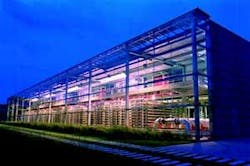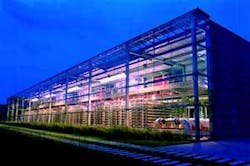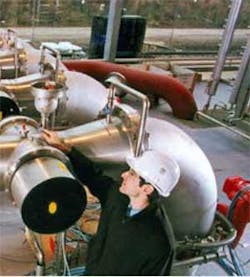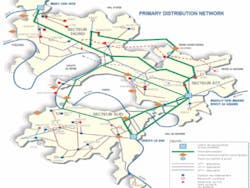Large Scale UV Disinfection System Treats Paris Drinking Water
By Simon Robb
Berson InLine 1500 ultraviolet disinfection units give added assurance of microbially safe water for 800,000 people served by SEDIF in French capital’s northern suburbs.
A large scale ultraviolet (UV) light disinfection system from Dutch UV specialist Berson UV-techniek is helping to treat drinking water for 800,000 people in the northern suburbs of Paris, France.
Adjacent to the Oise river in the suburb of Mérysur-Oise, the system is one of the largest European installations of Berson’s InLine range of UV equipment. Five InLine 1500 units are installed in parallel at the facility owned by the Greater Paris water authority, the Syndicat des Eaux d’Île-de-France (SEDIF) and operated by Compagnie Générale des Eaux part of Veolia Water. Featuring Berson’s medium pressure UV lamps, which are oriented perpendicular to the water flow to achieve optimum UV exposure, they provide disinfected drinking water at the rate of 170,000 cubic meters per day (m3/d).
An integral sensor monitors UV light intensity in each treatment chamber, while a custom-built control panel provides communication between the UV units and the plant control room. Also incorporated in each UV unit is an automatic wiping mechanism which cleans the quartz sleeves surrounding the lamps and keeps them free of waterborne deposits.
The Disinfection Process
UV works by irradiating or disrupting the DNA of microorganisms, rendering them unable to reproduce. It’s generally accepted that microbial DNA absorbs UV most effectively at 265 nanometers (nm), a wavelength that medium pressure lamps produce in abundance. In addition to emitting UV at this optimum peak wavelength, medium pressure lamps also emit UV over a very broad range of wavelengths (about 185-400 nm). Independent research has shown that, with proper pretreatment and a well-maintained UV disinfection system, this broad output causes permanent inactivation of both pathogenic and non-pathogenic microorganisms such as Escherichia coli, also known as E. coli.
Low pressure UV lamps, the common alternative to medium pressure lamps, produce just a single peak of UV output at 254 nm. While also having a strong germicidal effect, it has been shown that some microorganisms are able to repair or reactivate themselves after exposure to UV from low pressure lamps, especially if they’re subsequently exposed to sunlight. This is known as photoreactivation.
It’s thought that the permanent damage caused by medium pressure UV may be a result of the UV at other wavelengths, such as 240 nm and 280 nm, having an effect on other intracellular molecules such as RNA and enzymes, which are unable to repair themselves.
Two-Pronged Treatment Approach
The state-of-the-art treatment plant in Mérysur- Oise draws water from the Oise that passes through a physical filter, or screen, to remove large objects such as branches and plastic bags before entering a 370,000 m3 raw water storage tank reserve where it remains for two to three days, allowing small objects not already filtered to settle, or sink to the bottom. The water then takes two treatment paths:
Membrane filtration About 70% of the water passes through a membrane filtration system utilizing lamellate decantation, double-layered filtration, microfiltration, nanofiltration and degasification before undergoing UV disinfection. According to the operators, the Méry-sur-Oise plant was the first in the world to use nanofiltration as part of the process of producing drinking water from surface water.
Biological treatment The remaining 30% of the water passes through a biological treatment path utilizing decantation, sand filtration, ozonation, activated carbon filtration and chlorination.
The treated water from these two processes is then mixed before being distributed on the network, supplying 37 districts in the northern suburbs of Paris. The operators claim that the two-pronged treatment regime results in water of an exceptional softness and quality.
Conclusion
SEDIF supplies about four million people with drinking water. With little groundwater available in the Paris suburbs, 95% of the area’s water must come from three different rivers: the Oise, the Marne and the Seine. UV technology offers an added sense of assurance that the surface water is microbially free and clear without the unpleasant taste and odor of chemical disinfectants or potential chemical disinfection by-products.
Still, for waterworks utilizing UV technology, operators need to be sure the treatment is permanent. Existing research suggests medium pressure UV could provide better protection against photoreactivation than low pressure UV, especially if treatment occurs prior to any process units in which water is exposed to light.
Author’s Note:
Simon Robb is international area sales manager for Berson UV-techniek, a Halma company. The Nuenen, Netherlands-based company was founded in 1975 and manufactures closed vessel UV systems for municipal water and wastewater disinfection. Contact: +31 40 290 7777, [email protected] or www.bersonuv.com



